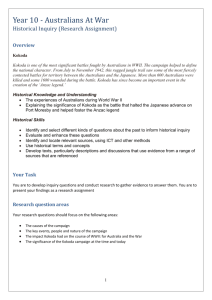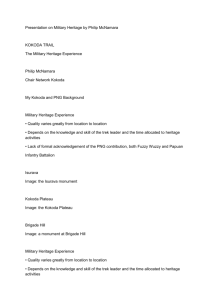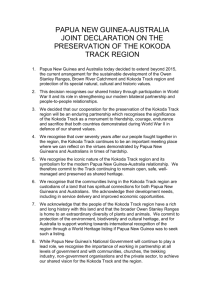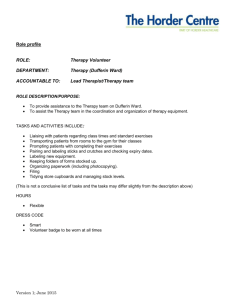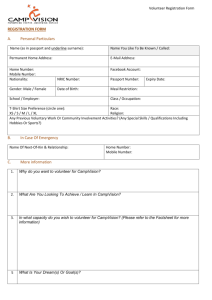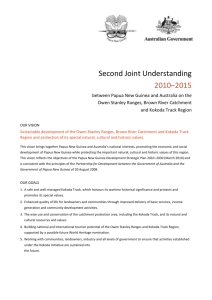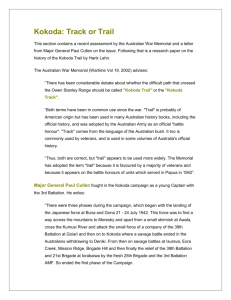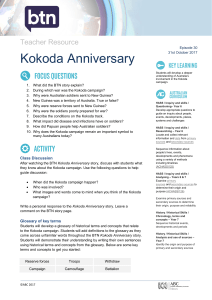Word - 34 KB - Department of the Environment
advertisement
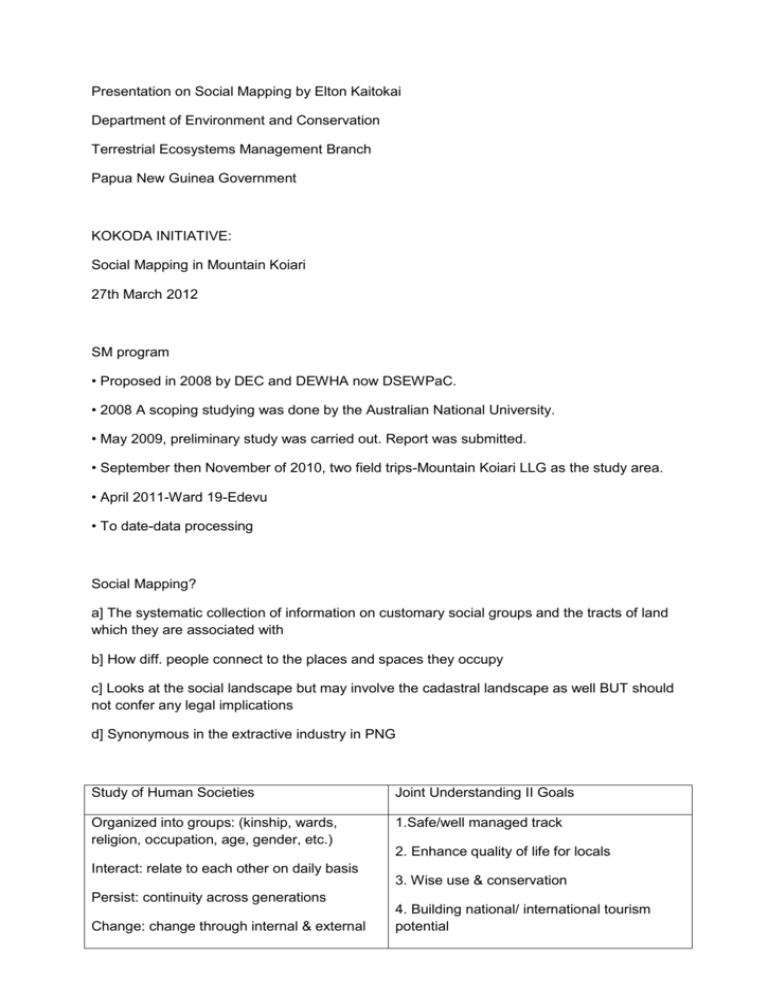
Presentation on Social Mapping by Elton Kaitokai Department of Environment and Conservation Terrestrial Ecosystems Management Branch Papua New Guinea Government KOKODA INITIATIVE: Social Mapping in Mountain Koiari 27th March 2012 SM program • Proposed in 2008 by DEC and DEWHA now DSEWPaC. • 2008 A scoping studying was done by the Australian National University. • May 2009, preliminary study was carried out. Report was submitted. • September then November of 2010, two field trips-Mountain Koiari LLG as the study area. • April 2011-Ward 19-Edevu • To date-data processing Social Mapping? a] The systematic collection of information on customary social groups and the tracts of land which they are associated with b] How diff. people connect to the places and spaces they occupy c] Looks at the social landscape but may involve the cadastral landscape as well BUT should not confer any legal implications d] Synonymous in the extractive industry in PNG Study of Human Societies Joint Understanding II Goals Organized into groups: (kinship, wards, religion, occupation, age, gender, etc.) 1.Safe/well managed track Interact: relate to each other on daily basis Persist: continuity across generations Change: change through internal & external 2. Enhance quality of life for locals 3. Wise use & conservation 4. Building national/ international tourism potential force 5. Working with communities (JU Goals & KI activities) Social Mapping Program Objectives Obtain information on; • Identity of Landowners • Land tenure (systems) • Customary and political organization • Formal organization • Oral history Purpose of collecting such information is to; • Understand the nature of customary rights/interest in project area • Provide a resource for com’ty planning and the appropriate targeting of social development programs • Assist with the management of biodiversity conservation • Assist with cultural heritage management • Assist with the implementation of REDD • Document the com’ty groups/legal entities which exist within the Study area and where possible the entire Initiative Area 2010-2011-Study Area Image: Detailed map overlaid with other maps and text boxes as follow Ward 17 Efogi -Efogi 1 &2, Enivilogo, Haelogo Ward 18 Manari-Manari, Loni, Naoro 1 & 2, Ebologo Madilogo, Ward 16 Boridi –Maraba, Daoi, Boridi, Milei, Manumu Ward 15 Kagi Kagi & Naduri SM & Mt Koiari •SM field work has covered a total of 5 wards (Koiari Rural), i.e:18 villages with 1 villages left 2 • Mt Koiari-rugged terrains, villages ~2 to 6km apart • Predominantly SDAs • Speak Koiari • Socially isolated till 1950s Social Mapping Approach • 3 fieldworks spanning 1-2 weeks each resulting in an overwhelming amount of data – Community Entry-via advance information sheet/track radio announcement & follow up on arrival @ village with a community forum Purpose: apart from com’ty entry becomes a means of obtaining CONSENT to conduct SM basically FPIC Informal Means/gestures of Consent; welcome songs, welcome notices, trad dancing, com’ty welcome parade, gift/lace presenting Formal consent seek through forum • Intensive structured/non structured interview Genealogies, history, myths, trad tributaries, local Mt names etc • General observations and photography • Cultural sites, • artefacts etc Data collection: Illustration Data collection: Illustration Data collection and type Images: maps, images of local areas, sites and people Images: Social mapping form and person Haelogo Population since1949 Year Tot.pop 1949 92 1953 84 Pop Diff -8 3 1955 91 +7 1956 100 +9 1958 102 +2 1959 102 00 1960 92 -10 1963 96 +4 1968 109 +13 1969 105 -4 2000 54 -51 2010 56 +2 Image: James Fewtrell with 103year-old Fuzzy Wuzzy Angel, Ovuru Ndiki’ Image: Tax- Census Sheet Genealogical Data analysis Images: Using SM software Commty Express Analysis by location and sex Mapping the descendents 1958 Tax census Findings: An Insight •Proportion people from Koiari who are non residents/absentees from each village covered is as high as 75 % • The principal factors driving emigration include weak income generating prospects, lack of health services, poor access to primary schooling, and lack of access to a high school. • Service access gets weaker as you move a way from the Kokoda Track corridor LOCAL ORGANISATION • Local-level governments • Ward make up-homogeneous vs. heterogeneous (isolated) • Special Purposes Authorities wards-4 plus 1non SPA ward 4 • Landowner companies & business groups (Ongoing Search) • Incorporated associations (ongoing) • Incorporated Land Groups (ongoing) • Trekking Industry for the track villages Other projects & IPZ Image: Map pointing out the following features: IPZ; Vabari proposed Agro Forestry; Binige Agro Forestry Program status Current study •Genealogy data-data entry 80% complete • Oral history-80% • Archival search-continuous • Final report-draft To be done • Madilogo • Follow up field work-Port Moresby Koiari • Kokoda SM-planning The Experience • While there are studies that look at the importance of the track from an Australian and Japanese point of view, the significance of the Kokoda Track to the people of Papua New Guinea also needs to assessed. • One challenge is to record the oral histories of the remaining few carriers who are still alive in PNG and to record the shared experiences of the villages at war. THANK YOU Elton KAITOKAI Program Officer Phone: 3014500 5 Email: ekaitokai@dec.gov.pg www.dec.gov.pg 6



